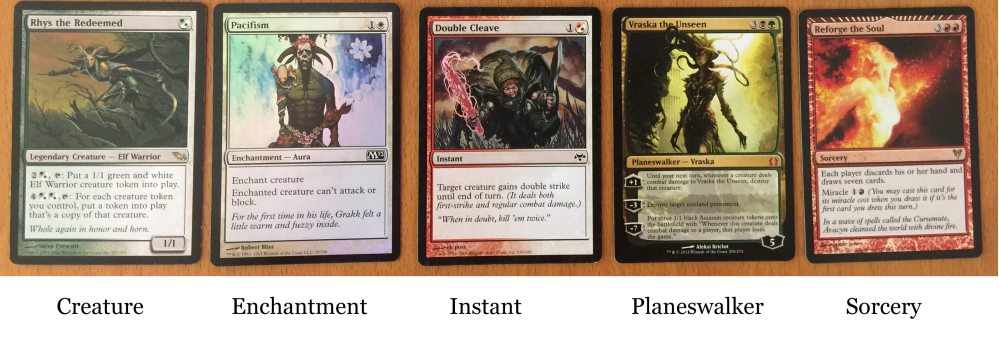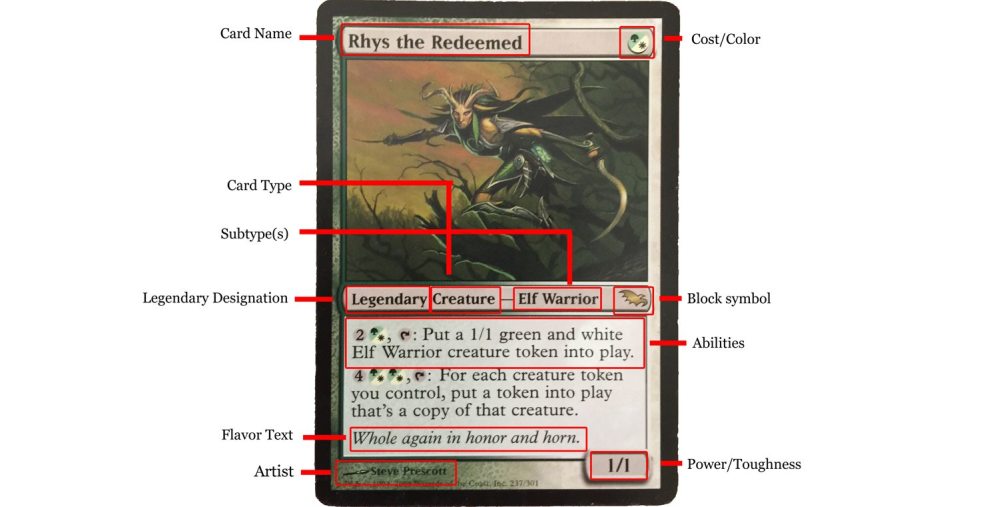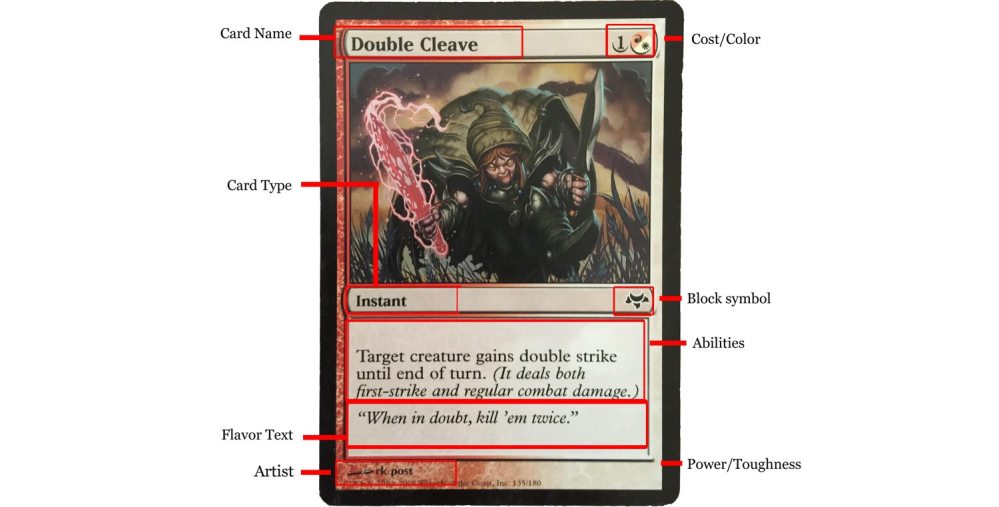
Trading Card Games (TCG) can have a lot to keep up with. The one thing a player needs to start playing is a collection of cards. In most games, you will need a minimum of 60 cards to play. You can buy starter decks, which come with a pre-made deck, and some booster cards to start your collection off. You can also find a deck list online, and order the cards individually.
Let’s explore some cards. Like I said in my previous post, I will be using Magic: the Gathering for my examples. The first thing you need to know is that Mana is the engine that powers your spells. You get mana by “tapping” Land cards. To tap a card, turn it 90 degrees clockwise.

The five basic land cards are Forest, Island, Mountain, Plains, and swamp. A player is not limited on how many of each s/he is allowed in a deck. Most players use 1-3 different kinds of lands in their decks. Each land produces mana of the corresponding color. Forest = Green, Island = Blue, Mountain = Red, Plains = White, Swamp = Black. To cast a spell, a player needs enough lands to provide the mana needed.

Creature, Enchant, Instant, Planeswalker, and Sorcery are five types of cards one might find in a M:tG deck. Artifacts and lands are special cards, and will each have a section further down. For now, let’s break down these cards.

Creature cards are just what they sound like. You summon creatures from around the multiverse to serve you in your battle. Let’s break it down:
- Card Name: A deck can only contain four (4) of each card name.
- Card Type: Creatures can only be cast on a player’s own turn, but not in combat.
- Subtype(s): Each subtype helps define the creature further. Rhys is an Elf (species) and is also a Warrior (Profession), making him a valid target for spells and abilities that affect Elves and Warriors.
- The Legendary subtype limits the number of copies you might have in play. You may only have one (1) copy of a Legendary creature in play at a time. This designation doesn’t change how many you might have in your deck.
- Flavor Text: This text helps tell the story that is being told when this creature is released.
- Artist: Each card credits the artist who made this card’s image happen.
- Cost: Each Creature costs a certain amount of mana. Adding all parts of a cost gives you a converted mana cost. The converted mana cost of Rhys is (1), and can be paid with White or Green mana.
- Color: Rhys is both Green and White, determined by the mana represented in the Cost of this card.
- Block Symbol: By looking here, you can see which block a card comes from, and the rarity of that card. Common cards are black, uncommon cards are silver, rare cards are gold, and bright golden orange emblems represent the mythic rarity. The rarity of a card significantly impacts its value in a deck, and monetarily.
- Abilities: Any given creature may have special abilities. Activated abilities have to be paid for. Costs can include mana, tapping, and/or sacrificing a card. Passive abilities are triggered by events during play.
- Power/Toughness: These stats determine how effective a creature is in battle. The left number is Power – the amount of damage the creature deals in combat. The right number is Toughness – how much damage an enemy must deal to this creature to kill it.

Enchantment cards change things permanently (or until they are removed).
- Subtype: Enchantments can affect the whole battlefield, a player, or a specific card. Auras like Pacifism affect one creature only.
- Cost/Color: Pacifism costs two mana, one of which has to be White.
- Notice there is no power or toughness: Although this card is a permanent addition to the field, it doesn’t have the ability to participate in combat.

Instant and Sorcery cards change things up as a one-time effect, and are immediately discarded after use.
- Card Type: An Instant spell can be cast any time, but a sorcery cannot be cast during combat, or during another player’s turn.
- Cost/Color: Double Cleave costs two total mana, and one of them has to be either Red or White.
- Notice there is not Power or Toughness. As temporary cards, instant and sorcery cards do not have intrinsic value in combat.

Planeswalkers are a powerful addition to any deck. They have special rules, and can be a game changer as soon as they hit the field.
- Planeswalkers have a unique limit: There can only be one (1) Vraska of any kind on your field at any given time. Some planeswalkers have many different types of cards. Jace, for example, has a half-dozen different names. A player can have 4 of each card, but only one Jace on the field at a time.
- Loyalty: A Planeswalker comes into play with Loyalty counters on them. Vraska comes in with five (5) Loyalty counters.
- Abilities: A Planeswalker’s loyalty goes up and down as they use their abilities. They can only use one during each of your turns. Usually, the third ability is expensive, and has a huge payoff if the payer is able to use it.
- Cost/Color: Planeswalkers cost mana to come onto the field. Vraska is both Black and Green, but is not a creature. She costs five (5) total, and she needs at least one Black and one Green mana to cost.
- Block symbol: Planeswalkers are usually Mythic rarity, and can be quite expensive to obtain.
When a player builds their deck, they have to have compatible colors. A player who built a Blue/Red deck won’t get much use from Forest cards, but would be nigh useless without Island and Mountain cards. The card types above will nearly always have a color type, but there is an exception: Artifact cards. These colorless cards can be played in most ever deck, because they (usually) don’t have any color requirements!

Artifacts can fill the roles of other types of cards, and are usually permanent additions to the field. Special spells are required to remove another player’s artifacts, meaning that it’s easy to keep many on the field at a time. Each artifact can fill the role of other spells, sometimes better than their counterpart could!
- Some artifacts act like Land cards. They cost mana to put onto the field, but then can provide different kinds of mana for the rest of the game, helping you fill the gaps if you don’t have the right Lands out when you start.
- Some artifacts act like field enchantments, providing an ongoing benefit or change for the rest of the game.
- Some artifacts give you access to instant-speed abilities that you can cast again and again, making them very powerful.
- Equipment cards are just like Aura Enchantment cards, with a catch: If the creature dies, you keep the Artifact! It can then be attached to another Creature card!
- Finally, Artifact Creatures are creatures that (usually) don’t require any particular color of mana to cast. This makes them flexible and viable in almost every deck.
For prospective collectors: The card market for any particular card is a bit like the stock market, with some minor shifts. Cards change value when they become available for certain formats, or are eliminated from certain formats. We’ll look at Decks and Formats in more detail later, but for now, just check out the prices at your local shops, and on the wide number of card databases online.
Finally, don’t worry about playing your newly-obtained $3,000 Black Lotus. You can always use a “proxy” card to represent your coveted collection piece. Most judges will require you to show the original card before joining a tournament, and will issue a proxy card at that time. Proxy cards are also used to represent two-sided cards in a deck, using proxy cards like the one below.

If you missed the first article in this series, check out our Introduction.
Join us later in the series to learn more about:


